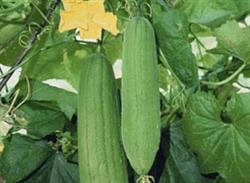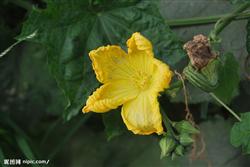Strengthening management to increase the yield of towel gourd in deep winter

In the case of low temperature in winter, the low yield of all kinds of vegetables makes vegetable farmers feel most powerless! In Handong Village, Luocheng Street, Shouguang City, the author visited Master Zhu, a veteran towel gourd grower in the village. due to the proper management, the towel gourd yield in Master Zhu's shed was also affected by low temperature, but it was much better than other towel gourd growers. He believes that according to the planting pattern of most towel gourd growers in Shouguang City, the low temperature period also happens to be the peak period of towel gourd fruit. therefore, if the overwintering towel gourd wants to fully obtain the high benefit of out-of-season production, the management of the fruit period is very important to strengthen the management. in order to maximize the yield of towel gourd! 1. Light and temperature adjustment in January and February towel gourd likes strong light, heat resistance, moisture tolerance and fear of cold. In order to prevent the invasion of low temperature and cold current, the light and temperature of overwintering towel gourd cultivated in out-of-season must be adjusted in time. The towel gourd in the overwintering season entered the peak stage of continuous flowering and fruiting, and the plant also entered the stage of vegetative growth and reproductive growth at the same time. Special attention should be paid to strengthening the management of light and humidity from January to February, so that the temperature in the greenhouse should be controlled at 24: 30 ℃ in the daytime, with a maximum of 32 ℃; at 12: 18 ℃ at night, the minimum temperature in the early morning should not be less than 10 ℃; in case of severe cold spell, the absolute minimum temperature in the shed should not be lower than 8 ℃. Because towel gourd has strong moisture resistance, in order to keep warm, it can reduce the number of ventilation and the amount of ventilation. In general, the greenhouse temperature with good heat preservation conditions is easier to control, and melon strips grow faster. 2. After the water and fertilizer supply entered the continuous flowering and fruiting stage, the vegetative growth and reproductive growth of the plant entered the peak period, the plant weight gradually increased, the melon yield increased, and the water and fertilizer consumption also increased gradually. In order to meet the demand of water and fertilizer for high yield cultivation of towel gourd, the interval time between watering and topdressing should be shortened gradually, and the amount of water and topdressing should be increased accordingly. In the early period of continuous flowering and fruiting period (January and February), every two crops of tender melons (that is, 20-25 days apart) were watered, and with watering, rotten chicken manure and human manure were applied, or humic acid type fertilizers were applied. Carbon dioxide gas fertilizer can be released in the shed if necessary. In the middle period of the continuous fruiting period of towel gourd from March to May, the application of available fertilizer and foliar spraying of available fertilizer should be carried out alternately, that is, water should be irrigated every 10 days or so, and quick-acting nitrogen, potassium and calcium compound fertilizer or organic compound fertilizer should be applied with water. Generally, 1012 kg is applied to every 667 square meters of shed field. At the same time, foliar fertilizer such as Fengshou No.1 was sprayed every 10 days to regulate plant growth. 3. Both the main vine and the side vine of towel gourd can bear melon. Under the condition of highly dense planting, it is advisable to keep single vine and pruning branches when overwintering towel gourd is cultivated in winter warm plastic greenhouse. Before fruiting melons and at the initial stage of continuous flowering, the axillary buds in the axils of the main vine leaves should be erased in time, leaving no lateral branches (vines), and each plant should leave a main vine on the hanger. In the middle of the middle period of continuous flowering and fruiting melon, in addition to using the main vine, the short side vine melon with 2-3 nodes can be left. That is, leave a melon on the side branch, and then keep one leaf to beat off the top, so that all the side branches of the whole plant have one melon each. In the late period of continuous flowering and fruiting, only the thin lateral branches should be wiped off as early as possible to protect the main vine and retain the growth of the well-growing lateral vine, and then pick the heart after 2 or 3 tender vines, so that several lateral vines and main vines on the same plant bear melons at the same time. 4. Cultivating strong vines teacher Zhu said that under the condition of low temperature and low light, towel gourd plants often grow slowly, the stems are thin and weak, the melon strips grow slowly, or the fruit falls. Therefore, the cultivation of strong vines is the key to get out of the predicament of low yield: first of all, stay melons late. In the low temperature season, the plant grows slowly, if the melon is left too early, it is easy to fall. In order to ensure the balance between vegetative growth and reproductive growth during the fruiting period, teacher Zhu believes that the first crop towel gourd should be kept when the plant grows to 22 leaves. After towel gourd enters the fruiting stage, in order to ensure the coordination of vegetative growth and reproductive growth, it should also be changed to 4-5 leaves to leave a melon, so that there is generally no premature senility. If the branches and vines are thin and weak during the towel gourd period, all the young melons should be removed in time, first promote vine growth, and then depend on the situation to decide to keep the melon. The second is to maintain the root system. Although the towel gourd root system is developed, the root growth rate is slow when the soil temperature is low in winter. If the one-time water and fertilizer is too large, it is easy to cause root injury, affect the root development, and then cause the stem vine to grow thin. Therefore, when watering and fertilizing, the amount of water should be as small as possible and must not be flooded. Fertiliser can choose biological fertilizer or humic acid type fertilizer to take root and raise root. There are many cloudy and foggy days in winter this year. In production, because they did not watch the weather forecast in advance, many vegetable farmers watered the first day, and the next day they encountered cooling and overcast snow, resulting in root damage. Therefore, special attention should be paid to weather changes in the process of vegetable management in winter. In the decision to watering, at least to ensure that there are two or three days of fine weather after watering, and should be carried out in the morning, after watering to close the shed to heat up, raise the ground temperature. In addition, disease-free vines should be cultivated. Botrytis cinerea, Sclerotinia sclerotiorum and bacterial soft rot are the main diseases that harm the growth of towel gourd in deep winter. In the process of management, it is necessary to "give priority to prevention and comprehensive prevention" to cultivate the disease-free strong vine of towel gourd.
- Prev

Skillfully using towel gourd leaves to treat animal diseases
1. Before sowing the towel gourd, the seeds were treated with 55-60 ℃ water for 15 minutes, then soaked in 25 ℃ water for 4 hours. After rinsing and removing the mucus from the seed coat, the seeds were wrapped in wet gauze and placed in an incubator to accelerate germination. Select the sprouted seeds to sow 1 to 2 seeds per bowl, generally about 500 grams per mu. Before emergence.
- Next

Multiple measures to control towel gourd rotten flowers
Towel gourd rotten flower has a lot to do with plant element deficiency, boron deficiency will cause towel gourd stigma blackening, many vegetable farmers will be used as infectious disease control. After the flower organ is damaged, it can not be remedied and can only be prevented in advance. Spraying with 500x borax solution or "Zhixin" boron fertilizer 1500 times liquid before towel gourd flowering can prevent stigma blackening caused by boron deficiency. ...
Related
- Where is it suitable to grow horseradish in China? it is expected to see the middle altitude horseradish in Alishan.
- How to prevent tomato virus disease reasonably? (Control methods included)
- Many people like to plant towel gourd on the balcony. What are the main points of this method and management?
- What crops can chili peppers be mixed with?
- Fertilization techniques and matters needing attention in Tomato
- What are the grafting techniques for peach seedlings in spring?
- Harm and control methods of root swelling disease of Chinese cabbage
- What are the pests of sweet potatoes? How to prevent and cure it?
- Symptoms, causes and Control methods of navel Rot in Tomato
- The cause of "Cucumber rotten bibcock" in Farmers' planting Cucumber and its Control Plan

